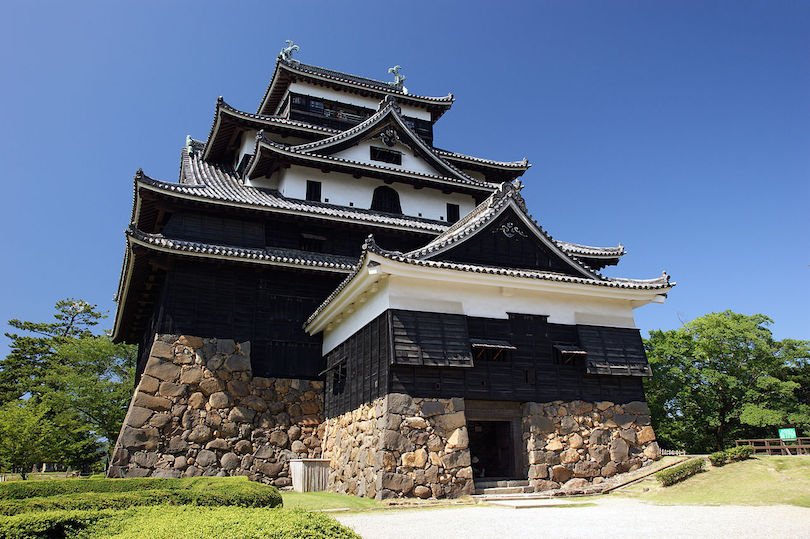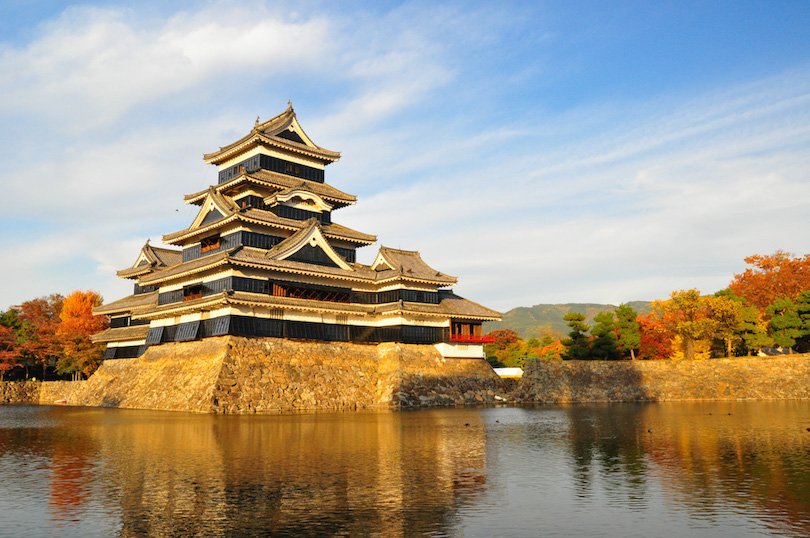5 Best Castles in Japan it may not conform to the traditional Western notion of an ancient fortress, but despite their distinct appearance from European castles, they were constructed for similar purposes. Their emergence in the Land of the Rising Sun dates back to the 15th century, a period marked by the fragmentation of the country into warring factions. Subsequently, they served as centers of governance and residences for feudal lords, known as daimyo.
At their peak, Japan boasted approximately five thousand castles, yet today, only around 100 remain, with a mere dozen surviving from the feudal era. These wooden and stone structures provide visitors with a rare opportunity to glimpse into Japan’s feudal past.
Matsumoto Castle[SEE MAP]
Matsumoto Castle, situated in the mountainous region of northwest Tokyo, boasts a stone structure surrounded by a vast moat. Its construction dates back to 1590, and its black trimmings have earned it the moniker of Crow Castle. The oldest donjon in Japan, the castle’s main keep offers panoramic views of the Hijiri Kōgen mountains. Despite being a hirajiro or flatland castle, Matsumoto was built with fortification in mind, featuring openings to fire arrows or drop stones on invaders throughout the keep.
Himeji Castle is one of the 5 Best Castles in Japan

Himeji Castle, located in the Hyōgo Prefecture west of Kōbe, is widely regarded as the most impressive of all feudal-era castles in Japan. Its white-plastered towers, resembling a snowy egret in flight, have earned it the nickname of the White Heron Castle. The castle was built in 1601 on the site of an earlier castle and comprises 83 structures centered on the Tenshu-gun, a complex of keeps and connecting buildings. The primary keep, a six-story structure, is visible from almost any location in Himeji City. Himeji Castle has been featured in numerous films, including the James Bond adventure film “You Only Live Twice” and “The Last Samurai,” starring Tom Cruise.
Hirosaki Castle[SEE MAP]
 Si-take / Wikipedia
Si-take / Wikipedia
Hirosaki Castle, located on a hilltop in northern Japan, is renowned for its five authentic turreted gates, fortified moats, and expansive grounds. Initially constructed in 1611, the original five-story donjon unfortunately succumbed to a fire in 1627. However, a three-story watchtower was subsequently renovated to serve as the main keep. The surrounding grounds, gates, and moats captivate visitors with their beauty, providing a serene garden atmosphere. With over 2,500 cherry trees planted, the grounds are also home to one of Japan’s grandest cherry blossom festivals held annually in spring.
Hikone Castle[SEE MAP]
Hikone Castle provides visitors with a genuine glimpse into the appearance of Japan’s castle complexes during their prime. The primary keep, along with the original gardens, gates, and guard houses, has been meticulously preserved. The Hikone complex incorporates structures and materials sourced from various castles across the country. It took 20 years to construct the castle on top of the hill, and it was finally completed in 1622. The Ii daimyo feudal lords maintained control over the castle until 1868. Adjacent to Hikone Castle, the Hikone Castle Museum showcases the treasures of the Ii dynasty, which include armor and musical instruments.
Matsue Castle[SEE MAP]
 663highland / Wikipedia
663highland / Wikipedia
Matsue Castle, the only remaining castle in the San’in Region on the southwest coast of Japan’s main island, is a unique structure that was built in a defensive, watchtower style but never saw any military action. Completed in 1611, the hilltop fortress was constructed after the last great feudal war and most of its complex was dismantled in 1875, leaving only the main keep and the ishigaki, or stone walls. The castle’s nickname, “The Black Tower,” comes from the striking ebony color of the keep. Visitors can explore the keep and the grounds, and boat tours are available around the outer moat. Reconstruction of the fortress began in the 1950s.







